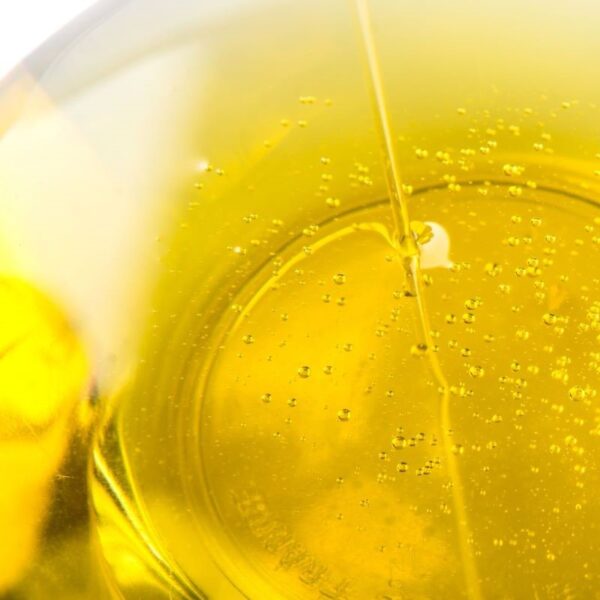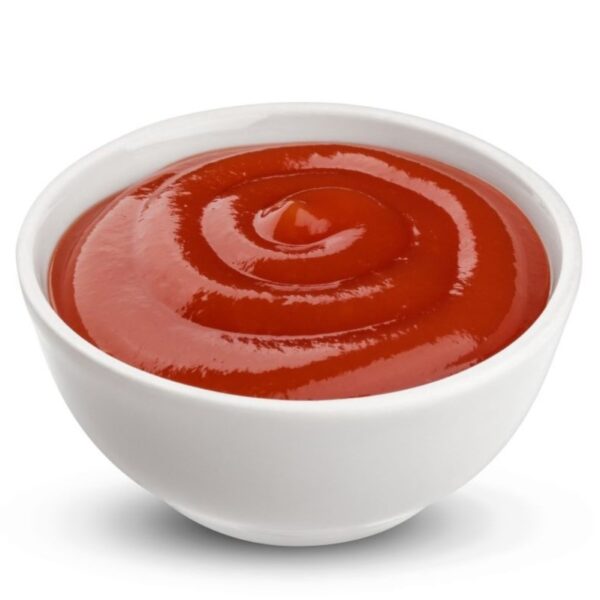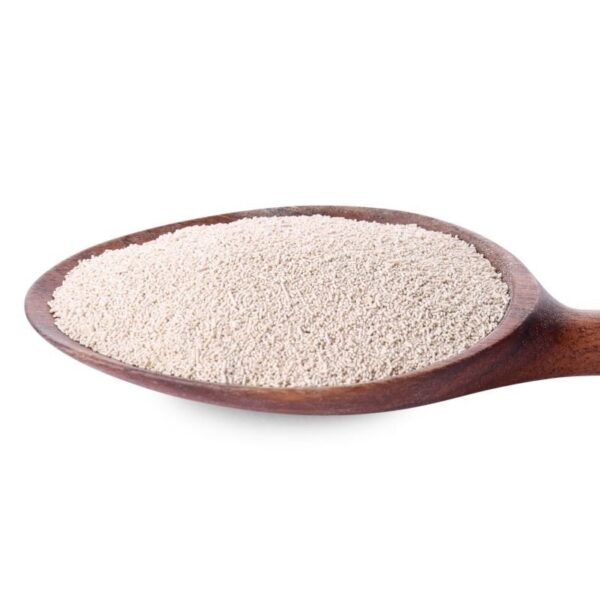Chitosan is a natural polymer and deacetylated derivative of chitin, which is the primary component of the exoskeleton of crustaceans and is the second most abundant polysaccharide found in nature (after cellulose). Chitosan is non-toxic, biodegradable, biofunctional, and biocompatible, with antimicrobial characteristics. In addition, chitosan serves as an excellent edible film component due to its film-forming capacity and ability to form transparent films.
What is Chitosan?
The molecule of chitosan consists of N-acetyl-2-amino-2-deoxy-d-glucopyranose (acetylated unit) and 2-amino-2-deoxyd-glucopyranose (deacetylated unit), where the repeating units are linked by β-(1→4)-glycosidic bonds. The reactive groups found in chitosan are a primary amino group (C2) and primary and secondary hydroxyl groups (C6, C3). Glycosidic bonds and the acetamide group can also be considered functional groups. These functional groups allow for various modifications, producing polymers with various properties and behaviors.
Source: Wikipedia
How is Chitosan Produced?
Chitosan is a naturally occurring polysaccharide obtained from the deacetylation of chitin, either by chemical, enzymatic, or microwave-assisted methods. The production process involves shell pretreatment, demineralization, deproteinization, depigmentation (if required), deacetylation, filtration, and drying. The resulting chitosan can be further processed into different forms for various applications.
Applications in Food and Nutrition
| Function | Applications |
| Film-Forming Agent | Edible coatings, anti-microbial coatings, sprays |
| Encapsulating Agent | Capsules, microcapsules, nanoparticle delivery systems |
| Antimicrobial Agent | Anti-microbial coatings, food preservation |
Properties of Chitosan
| Physical Form | Powder |
| Color | Yellowish-white to off-white |
| Odor | Odorless to characteristic (fishy odor if derived from marina sources) |
| Storage Temperature & Conditions | 20°C |
| Molecular Weight | 3800-20,000 Daltons |
| Appearance | Powder with a slightly rough surface and irregularly shaped particles |
| Density | 0.15-0.3 g/cm3 |
| Viscosity 1 wt. % in 1% acetic acid (25 °C) | 200-800 cP |
| Gelling Temperature | 72°C |
| Tg (Glass Transition Temperature) | 73°C |
| Melting Point | 102.5°C |
| logP | -11.706 |
| Solubility | Soluble in dilute aqueous acids |
Typical Formulations
Edible Food Coating
Here is an example of a food coating formulation with chitosan, along with the % weight of ingredients:
| Ingredient | Concentration (%w/v) |
| Chitosan | 1.5-2.0 |
| Lactic acid | 1 % |
| Chestnut extract | 0.5-1.0 |
| Glycerol (plasticizer) | 0.45-1.8 |
| Water | Make up to 100% |
This formulation used chitosan as a biopolymer to form a non-toxic, biodegradable, and biocompatible film with anti-microbial properties. Incorporating glycerol (plasticizer) minimizes the rigidness and brittles of the film. Chestnut extract (an active component rich in hydrolyzable tannins) can produce films with enhanced antimicrobial and/or antioxidant properties.
Source: Science Direct
Hydrophobic Chitosan Edible Coating
Here is an example of a food coating formulation with chitosan, along with the % weight of ingredients:
| Ingredient | Concentration |
| Chitosan | 2% |
| Glycerol | 0.5% |
| Soy lecithin | 0-0.5% |
| Olive oil | 0-2% |
| Water | Make up to 100% |
In this formulation, monolayer barriers in the form of films were prepared by casting filmogenic emulsions composed of 2% w/v chitosan and 1% (w/v) lactic acid. Soy lecithin was used as a surfactant, and olive oil as a hydrophobic barrier.
Source: MDPI
Encapsulation Matrix
Chitosan can be used to encapsulate phycocyanin. This product formulation prepared a chitosan solution of 3% w/v with 1% acetic acid. At the ratio of 1:1, the solution was stirred until homogeneous and dripped slowly through a syringe to Na-Citrate 4% (w/v) crosslinker solution.
Chitosan Formulation Considerations
| Physical Forms | Powder, crystals |
| Stability | Generally, shear stress, dissolved oxygen, and high temperatures may all cause chitosan to deteriorate. For instance, chitosan undergoes heat degradation at temperatures higher than 280°C, which causes polymer chains to break down quickly and reduce their molecular weight. |
| Interaction with Other Components | Incompatible with strong oxidizing agents |
| Source | Crustaceans, principally crabs and shrimps, Luffa spp, cell walls of fungi |
| Dosage | 0.5-5%, depending on the application and desired effect |
| Morphologies | Films, capsules, hydrogels, nanofilms, nanofibers, nanoparticles, nanocapsules, nanomembranes, nanosponges, and nano scaffolds |
Solubility
Chitosan is generally amorphous, meaning it is almost insoluble in water due to strong intermolecular hydrogen bonds between polymer chains. Large amounts of protonated -NH2 groups on the chitosan structure account for its solubility in acid-aqueous media since its pKa value is approximately 6.5.
However, chitosan can dissolve in an aqueous solution when the pH is below 6 due to protonation of the amino groups. Increasing the solubility in alkaline solutions can be done with several chemical modifications, including attaching the carboxymethyl group to the chitosan structure and retaining its cationic structure.
Chitosan solubility depends on various factors, such as polymer molecular weight, degree of acetylation, pH, temperature, and polymer crystallinity. Further modifications, such as deacetylation, reduction in crystal size, and use of hydrogen bond disruptors, are also reported to alter the solubility of chitosan in water.
Factors Affecting Chitosan Polymer Characteristics
The source and extraction method used to obtain chitosan directly impact its properties. The primary properties that determine the efficacy and scope of applications for chitosan include particle size, molecular weight, crystalline structure, level of deacetylation, and surface area, as described in the table below.
| Factor | Effect |
| Molecular Weight | The molecular weight of chitosan depends on how many monomeric units are in the biopolymer. Viscosity and solubility are impacted by molecular weight, and for this reason, their control, assessment, and modification are crucial. |
| Deacetylation Degree | The degree of deacetylation determines the free amino groups exposed due to removing the acetyl groups from the molecular chain of chitin. When the percentage of 2-amino-2-deoxy-D-glucopyranose units reaches 50%, the polymer is typically known as chitosan and becomes soluble in aqueous acidic environments. The degree of acetylation controls the number of available free amine groups and the accessibility of water (for hydration of dry sorbent) and metal ions to the sorption sites. Many available amino groups on the chitosan structure are expected to translate into a more effective sorption capacity of metal ions. |
| Crystallinity | Crystallinity reflects the proportion of the biopolymer’s crystalline and its amorphous fractions, which influences how chitosan swells and its porosity, water absorption, and moisture retention. |
| Porosity & Particle Size | Chitosan applications like adsorption and enzyme immobilization require several accessible sites and a porous structure; therefore, surface area and particle size are crucial factors. |
| Change in pH | pH has a significant effect on the solubility behavior of chitosan. As per a study, chitosan started precipitating out of the acidic solution upon an increase in pH, resulting in co-aggregation at a pH of 7.8-7.9. Another study revealed that the physical crosslinking pattern induced by solution pH significantly affects hydrogel elastic moduli for chitosan. |
| Concentration | Concentration in solution has a significant impact on the rheological properties of chitosan. In a study, the chitosan solution’s non-Newtonian nature (elastic properties and shear-thinning behavior) increased with increasing chitosan concentration and decreasing ionic strength. |
| Degree of Crosslinking | Crosslinking agents have emerged to improve the properties of chitosan film, including its mechanical properties, water resistance, thermal stability, and swelling degree. |
| Chemical Modifications | Modification methods primarily consist of N-substitution in C2–NH2, O-substitution in C6–OH, and free radical graft copolymerization. A detailed summary of the effect of chemical modifications on the properties of chitosan can be found here. |
Differences in Properties of Chitosan with Different Molecular Weights
The physicochemical and biological properties of chitosan vary per molecular weight. A summary of these variations is given in the table below.
| Property | Low molecular weight chitosan (>150 kDa) | Medium molecular weight chitosan (150–700 kDa) | High molecular weight chitosan (>700 kDa) |
| Physicochemical | – High nitrogen content – Higher solubility – Low viscosity – High permeability – Has chelating and complexing properties | – Medium nitrogen content – Limited solubility – Pseudoplastic behavior (medium viscosity) – Medium permeability – Good reactive groups for crosslinking | – Low nitrogen content – Limited solubility – Pseudoplastic behavior (high viscosity) – Low permeability – Low reactive groups for crosslinking |
| Biological | – High antioxidant activity – Biocompatible, non-toxic, and biodegradable – Antimicrobial | – High antioxidant activity – Biocompatible, non-toxic, and biodegradable – Antimicrobial | – Low antioxidant activity – Biocompatible, non-toxic, and biodegradable – Antimicrobial |
Source: MDPI
Chitosan as an Encapsulating Matrix
Chitosan is a suitable carrier for delivering nutraceuticals and actives as it is non-toxic, biodegradable, and biocompatible. It has encapsulated various bioactives, including bioactive peptides, vitamins, essential oils, caffeine, plant extracts, fatty acids, flavonoids, carotenoids, and terpenes.
Advantages
- Chitosan is a naturally positively charged biopolymer. It has an affinity for negatively charged bioactive molecules, such as antigens, antibodies, enzymes, cytokines, and polyanionic polymers.
- Chitosan encapsulation can protect bioactive ingredients from extreme conditions, including extreme changes in pH and temperature. Chitosan with a high deacetylation degree and high molecular weight shows the relative permeability of the epithelium and thus improves the transport of polar drugs through epithelial surfaces.
- Chitosan-based drug nanoparticles can be employed for diagnostic imaging and delivering the drug to particular targeted sites in a regulated manner.
- Chitosan becomes bioadhesive and binds easily to negatively charged surfaces, such as mucosal membranes.
- The release kinetics of chitosan microcapsules can be manipulated by altering the shell thickness, density, and chemical modifications of chitosan.
- Chitosan-based drug nanoparticles show bi-phasic release, an initial burst release followed by a controlled release.
- Chitosan can also be combined with other polymers to encapsulate various drugs and actives to achieve targets with performance delivery.
Disadvantages
- The release of actives from natural polymers from nanoparticles occurs relatively quickly because they decompose within a few hours. Synthetic polymers can withstand degradation in the body for long periods.
Applications
- Targeted drug release and enteric-coated drug delivery solutions
- Modified drug release solutions: extended release, sustained release
- Nutraceutical and pharmaceutical dosage forms: capsules, granules, tablet coatings
- Encapsulation of bioactives for extended shelf life
- Immobilization of microorganisms and enzymes, antigens, and antibodies
- Nanoscaffolds for delivery of actives and wound healing
Chitosan as a Film-Forming Agent
Chitosan also has a very good film-forming capacity, which is useful in building edible films and coatings with antimicrobial properties to improve food safety and shelf life. Solvent-casting methodologies easily produce chitosan films, but more complex films can be produced by blending the polymer with others such as pectin or by producing layer-by-layer films with negatively charged polymers like polyacid, poly (lactic-co-glycolic acid), or polylactic.
Effects of Various Factors & Additives on Film Properties
| Factor/Additive | Effect on Film Properties | Examples |
| Concentration | Higher chitosan concentrations (the number of chitosan molecules per unit volume) result in strong interactions between chitosan molecular chains and increased intermolecular crosslinking. This leads to a relatively compact film structure. | |
| Plasticizer | Plasticizers are usually applied to improve the flexibility of edible films or coatings, and crosslinkers limit their solubility and improve mechanical strength].In a study, the flow index of a film-forming solution increased, and apparent viscosity decreased with an increase in plasticizer concentration. | Glycerol, ethylene glycol, polyethylene glycol, and propylene glycol |
| Lipids | Lipids are added to chitosan films to overcome the drawback of chitosan being a hydrophilic material that limits the range of its applications. Chitosan is usually combined with lipids to form bilayer or emulsion films. Different lipids (fats and oils) have been incorporated into film-forming solutions to form emulsion-based structures. | Animal fats and plant waxes, vegetable oils, and fatty acids |
| Cross-Linking Agents | Cross-linking agents modify the physical and mechanical properties of the polymer and the rheological properties. Different crosslinkers have been reported for chitosan, resulting in better mechanical properties, reduced swelling behavior, and hydrophilicity. | Glutaraldehyde, glyoxal, formaldehyde, sodium tripolyphosphate, sodium citrate |
| Emulsifier | Emulsifiers such as lecithin have been added to emulsion film and coating formulations to improve their functional characteristics by stabilizing dispersed systems in composite emulsion-based edible films. | Lecithin, monoglycerides |
Advantages
- Films made with chitosan have inherent antimicrobial properties to prevent deteriorative microbial changes in foods.
- Compared to other bio-based food packaging materials, chitosan-based films are known as effective carriers of many functional ingredients, such as antimicrobial agents and antioxidants, to extend the shelf life and quality of food.
- Chitosan provides excellent biocompatibility and/or biodegradability, which synthetic polymers cannot provide in films.
Applications
- Edible coatings
- Water purification
- Immobilization
Advancements
- Blended Films: Blended films or coatings of chitosan combined with other biopolymers have been fabricated using solution-casting, layer-by-layer, extrusion, and other techniques.
- Emulsion-Based Coatings: The properties of emulsion-based films depend on the lipids’ nature, the fatty acids’ chain length, and the structure of the dried emulsion that constitutes the film. Oils can improve the moisture-barrier properties of hydrophilic films, preventing drastic changes in the mechanical properties of the emulsified films.
Chitosan as an Anti-Microbial Agent
The antimicrobial activity of chitosan depends on a range of elements, including species of microorganisms, molecular weight, degrees of deacetylation, chemical structure, and derivation.
One of the reasons for the antimicrobial character of chitosan is its positively charged amino group, which interacts with negatively charged microbial cell membranes and leads to the leakage of proteinaceous and other intracellular constituents of the microorganisms. It has three different functional groups: primary alcohol, secondary alcohol, and –NH2 groups, which inhibit the growth of various bacteria and fungi. Forming an external barrier, chelating metals, and suppressing essential nutrients to microbial growth are also ways in which chitosan prevents microbial growth.
The effect of chitosan-based antimicrobial drugs can be found in detail here.
Advantages
- Chitosan is a nontoxic natural antimicrobial polymer approved as GRAS.
- Chitosan and chitosan derivatives can kill microbes by neutralizing negative charges on the microbial surface.
- Chitosan has been observed to act more quickly on fungi than on bacteria, and its activity against typhoid organisms is comparable to the standard antibiotics used in clinical practice.
- Chitosan is soluble in an acidic environment. The limited activity above pH 6 may originate from poor solubility. However, chitosan was observed to be equally active against S. aureus at pH 5.5 and 7.2 (MIC = 256 μg/mL).
- Chitosan can be a potential anti-biofilm agent. Chitosan and chitosan derivatives in different structural forms exhibit activity against microbial biofilm.
- Chitosan and its derivatives can serve as antimicrobial drug delivery vehicles, as prebiotics to improve the colonization resistance against enteric infections, and as antimicrobial agents. They can perform these functions independently and conjugate with other reactive agents to increase antimicrobial activities.
Applications
- Wound dressings
- Antimicrobial coatings in food packaging
- Antibiofilm agent
- Edible food preservative coating and gels
Health Benefits of Chitosan and Applications as Nutraceutical
- Immunomodulatory Effect: Chitosan has been shown to exert pro- and anti-inflammatory effects on immune cells. Chitosan exhibits considerable immunostimulatory activity by inducing innate immune cells to release a wide range of pro- and anti-inflammatory cytokines, chemokines, growth factors, and bioactive lipids.
For this reason, it promotes and supports every phase of wound healing, including hemostasis, inflammation, cell migration, and proliferation. - Hepatoprotective Property: Reduces EMB-related liver toxicity that results from biochemical, histopathological, gene expression, and DNA damage.
- Antioxidant Activity: Antioxidant agents like chitosan play a role in scavenging free radicals and inhibiting the oxidative damage caused by free radicals.
- Cardioprotective Activity: Chitosan can help prevent cardiac cell damage through antioxidative stress by decreasing the reactive oxygen species.
- Anti-Cancer Activity: With a regulated degree of deacetylation, chitosan strongly affects cell-polymer interaction on cell death by breaking the cell membrane. It prevents tumor cell growth by proliferating cytolytic T lymphocytes.
- Blood Coagulation: Chitosan can interact with the blood coagulation process (e.g., platelets, red blood cells, coagulation factors), accelerating hemostasis, increasing monocyte/macrophage migration, and stimulating collagen synthesis.
Safety & Regulatory Considerations
| FDA Information | In the United States, chitosan is generally recognized as safe (GRAS) by the Food and Drug Administration (FDA) for use as a food ingredient. |
| EU Information | In the European Union, chitosan is considered a novel food ingredient, and the European Commission regulates its use in food. It must undergo a safety assessment by the European Food Safety Authority (EFSA) before it can be approved for use in food products. |
Safety & Toxicity of Chitosan
Chitosan is a natural polysaccharide with great biocompatibility and low toxicity. In a study, no toxicity was observed in animals at concentrations up to 5%.
Identification Numbers
| CAS Number | 9012-76-4 |
| EC Number | 618-480-0 |
Fun Facts About Chitosan
- Chitosan-based materials have been explored in biomedical implants, including drug delivery systems and tissue engineering scaffolds due to their biocompatibility and biodegradability.
- Chitosan is biodegradable, which means it can break down naturally in the environment. This makes it an eco-friendly material for various applications, including agriculture and medicine.
Additional Resources
- PubMed Central – Article on Alginate-Chitosan Hydrogels
- ACS Publications – Article on Alginate-Chitosan Polyelectrolyte Complexes
- PubMed Central – Study on Chitosan-Alginate Biocomposites
- ScienceDirect – Article on Alginate-Chitosan Beads
- MDPI – Polymers Journal on Chitosan and Alginate
- Wiley Online Library – Book Chapter on Alginate-Chitosan Interactions
- ScienceDirect – Article on Chitosan-Alginate Microcapsules
- PubMed – Study on Chitosan-Based Films
- ScienceDirect – Article on Chitosan-Alginate Composite Films
- PubMed Central – Research on Chitosan-Alginate Mixtures
- CORE – PDF on Chitosan/Alginate Nanoparticles
- PubMed Central – Study on Alginate-Chitosan Microcapsules
- HAL Archives – Document on Chitosan/Alginate Mixtures






